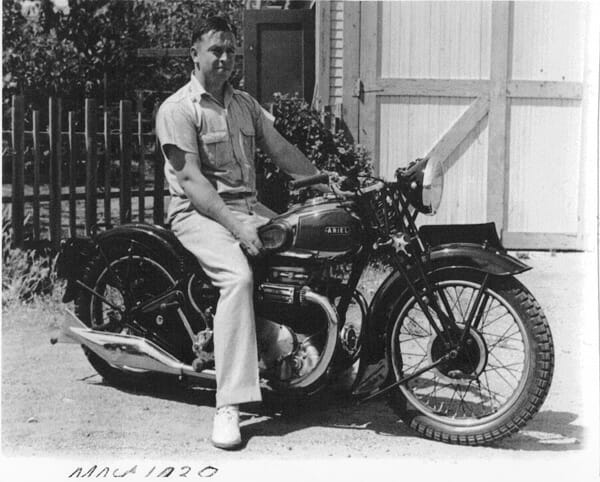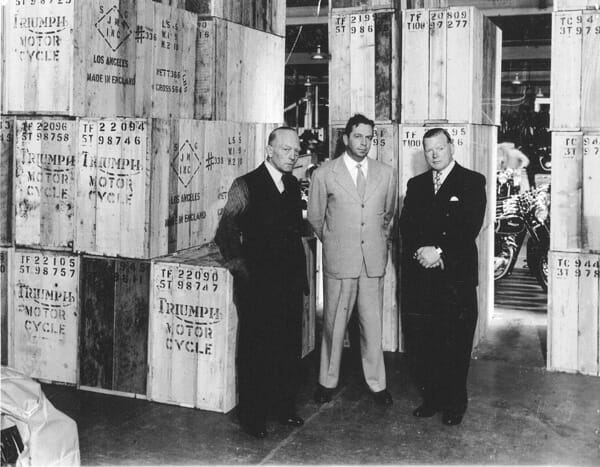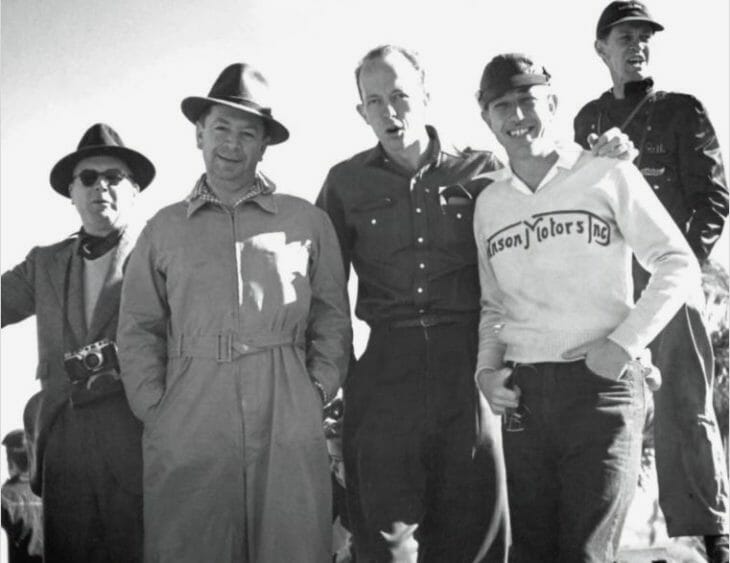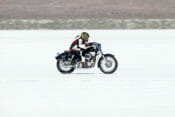Archives: America’s Man of Triumph
Bill Johnson helped establish Triumph Motorcycles in the United States. His company, Johnson Motors, imported and sold British-made motorcycles starting in the late 1930s when foreign-made motorcycles where a rare sight on American roads. Johnson also helped revolutionize the way motorcycles were sold. He opened a dealership in Pasadena on a busy street in the high-rent district of town. The dealership featured a roomy two-story showroom with floor-to-ceiling glass that tastefully displayed the machines. Johnson also believed in racing as an excellent form of advertising. He backed many of the leading riders of the 1940 to 1960s and sponsored many racing events across the United States during the same period.
Archives: America’s Man of Triumph

Johnson had a most unlikely background to become involved in motorcycling. William Johnson, Jr., was born in Winnemucca, Nevada, in 1905 into a wealthy family. His father was a vice president with Bank of America. Johnson grew up in San Francisco and while he came from a privileged background his father believed in teaching young Bill to earn his own way. While attending Stanford University, Johnson paid his way through school by working various menial jobs, including stints as a milk man, hotel clerk and grape picker in the San Joaquin Valley.
He showed no interest in motorcycles and thought little about them except for a group of riders he often encountered while returning to school on Sundays. The group rode, as Johnson described, “hell for leather” on the twisty mountain roads.
“If truth were known, I dare say that some of my good friends of today in San Francisco were participating in those Sunday rides,” Johnson wrote years later.
He graduated from Stanford and later the University of Southern California Law School. After earning his law degree, Johnson appeared destined to take the typical path of practicing law. He indeed started a law firm in Los Angeles. In 1936, while vacationing in Hawaii, Johnson saw a Motorglide scooter being used on the island as a delivery vehicle. When he returned home he bought one of the scooters and met Foster Salsbury, who owned the Los Angeles-based Salsbury Corporation, which manufactured the scooter. Ed Brady, Johnson’s brother-in-law, and Johnson were so enthused about the scooter business that they became associated with the Salsbury Corporation.
By the mid-1930s, Johnson, who became an avid reader of the British motorcycling publications, ordered an Ariel Square Four. He was so impressed with the fit and finish of the Ariel he felt certain the American market was ripe for the relatively refined British motorcycles. Johnson discussed the idea of importing British motorcycles to America with his business partner and accountant Wilbur Cedar. Cedar was older and had a solid financial background. Johnson trusted his judgment and when Cedar agreed that the proposition was reasonable, Johnson decided to go into the motorcycle business.
In 1938, Johnson established British and American Motors (later to be re-named Johnson Motors) in Pasadena. Johnson recalled in a 1951 article for Motorcyclist Magazine one humorous incident that happened shortly after he opened the company.
“On Sunday I was cleaning up the place, dressed in overalls and alone. Two men whom I immediately recognized as prominent in motorcycle circles, walked in. I sensed they did not recognize me, so I went about my job, but couldn’t help hearing their conversation. The gist of it was that this chap Johnson ‘will never make a success of this business’ as it’s been tried before without success. I gathered that I had the reputation of being most affluent and somewhat of a playboy, and this motorcycle adventure was something of a hobby.”
Johnson attended races nearly every weekend in the early days in order to promote Triumph. A rider named Bruce “Boo-Boo” Pearson began to achieve success on the racing circuits, but the motorcycle publications of the era were closely tied to the American-made brands and went out of their way, according to Johnson, to ignore the Pearson’s victories. After much persuasion and protest to the magazines, Johnson was able to get a bit of recognition for Triumph’s early racing successes.
Johnson worked tirelessly to promote Triumph and was making strides when World War II broke out and halted production. He kept his business alive by buying used machining equipment and operating a tool and die business that supported America’s war effort.

When the war came to a close, Johnson moved his business from Los Angeles back to Pasadena and purchased a former luxury automobile dealership showroom for the then princely sum of $85,000. At this point, he dropped his Indian franchise to better concentrate on Triumph. Johnson Motors’ new dealership was state-of-the-art in every way, featuring a tall glass façade, polished tile showroom floor, a spacious parts department and six hydraulic lifts in the fully equipped service department. In fact, some thought the gleaming establishment too ostentatious for the motorcycling crowd, but they were proven wrong when the business flourished during the post-war boom in motorcycling.
Johnson Motors (or JoMo as it was commonly referred to) was named Triumph’s official U.S. distributor in 1944.
Johnson was quick to recognize the advantage of using movie stars to help promote not only Triumph, but also motorcycling in general. A plethora of TV and movie stars, including Robert Taylor, Rita Hayworth, Robert Stack and Keenan Wynn, agreed to publicity photos for Triumph. Some stars, like Wynn and Lee Marvin, raced Triumphs in amateur events and gladly repaid Johnson’s support with free publicity. A young Steve McQueen bought one of his first motorcycles from Johnson, who introduced McQueen to Bud Ekins. McQueen and Ekins became fast friends and later united to help put together an American ISDT team.
Mass media proved to be an excellent way to promote the sport and Johnson again was on the leading edge in that regard. Johnson Motors sponsored the first-of-its-kind weekly radio program that covered all aspects of motorcycling. Johnson’s savvy use of the media and Hollywood stars helped create a new aura of “coolness” around motorcycling.

Racing greats such as Ed Kretz, Sr. and Jr., Jimmy Phillips, Johnny Gibson, Joe Leonard, Sammy Tanner, Bud Ekins, Eddie Mulder and Skip Van Leeuwen, just to name a few, all raced under the Johnson Motors banner. The one race Johnson coveted most was the Daytona 200. Ironically, he died just a few hours before Don Burnett took the checkered flag in Daytona Beach, Florida, giving Triumph its first win in the prestigious race.
Johnson Motors was eventually absorbed into the amalgamated BSA-Triumph headquarters in the 1970s.
A man of never-ending curiosity, Johnson became a self-taught machinist, was an avid collector of guns and photographic equipment and despite his degrees continued his education later in life via correspondence courses in writing and journalism.
Johnson made many friends in the motorcycling industry during his years in the business. His leadership, acumen, business style and commitment to the sport set new standards. The Japanese motorcycle makers emulated many of his innovative business practices when they came to America. Johnson believed the keynote of success in business was cooperation and good will.
Johnson died in 1962. He was inducted into the AMA Motorcycle Hall of Fame in 2005.
